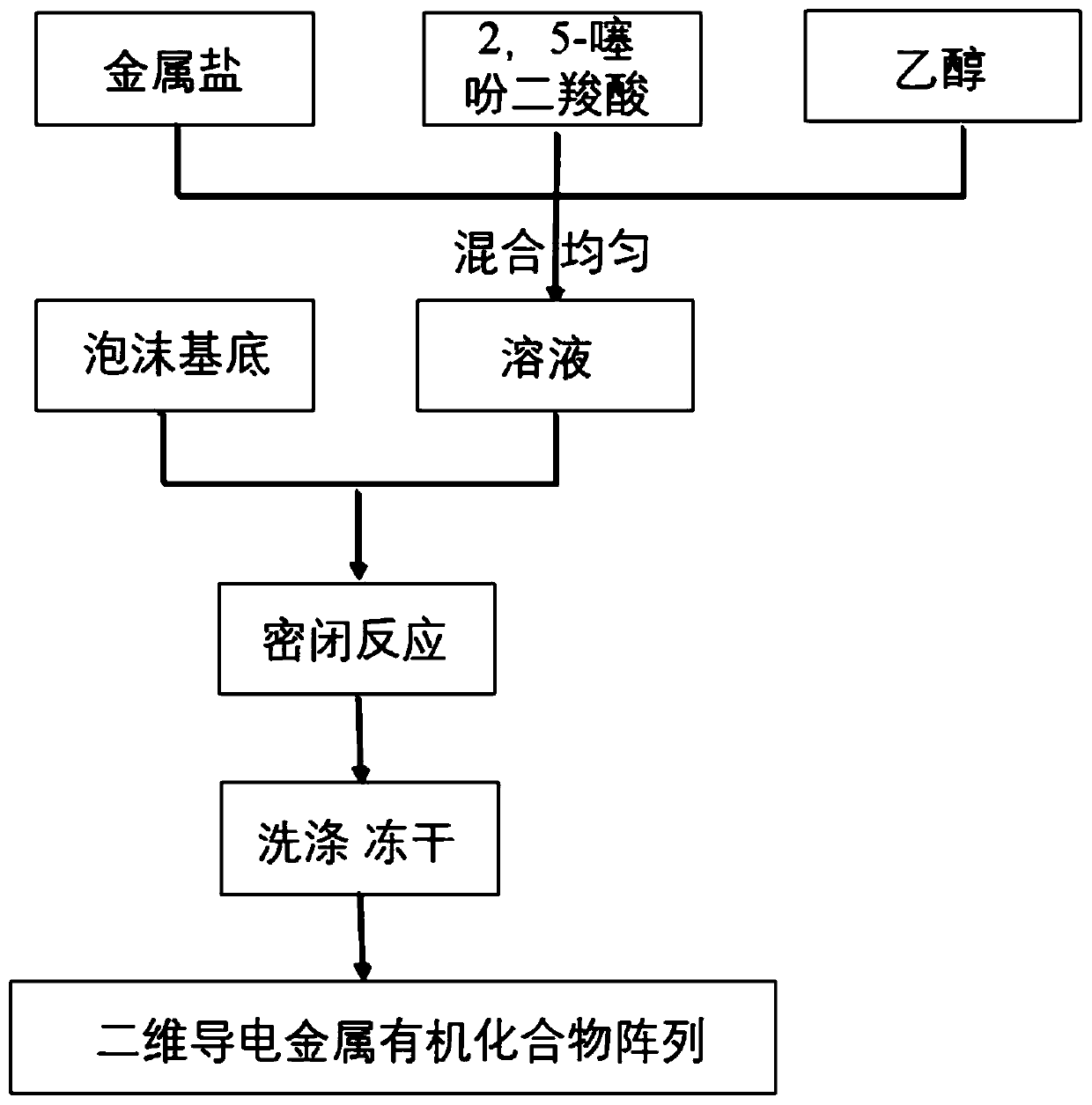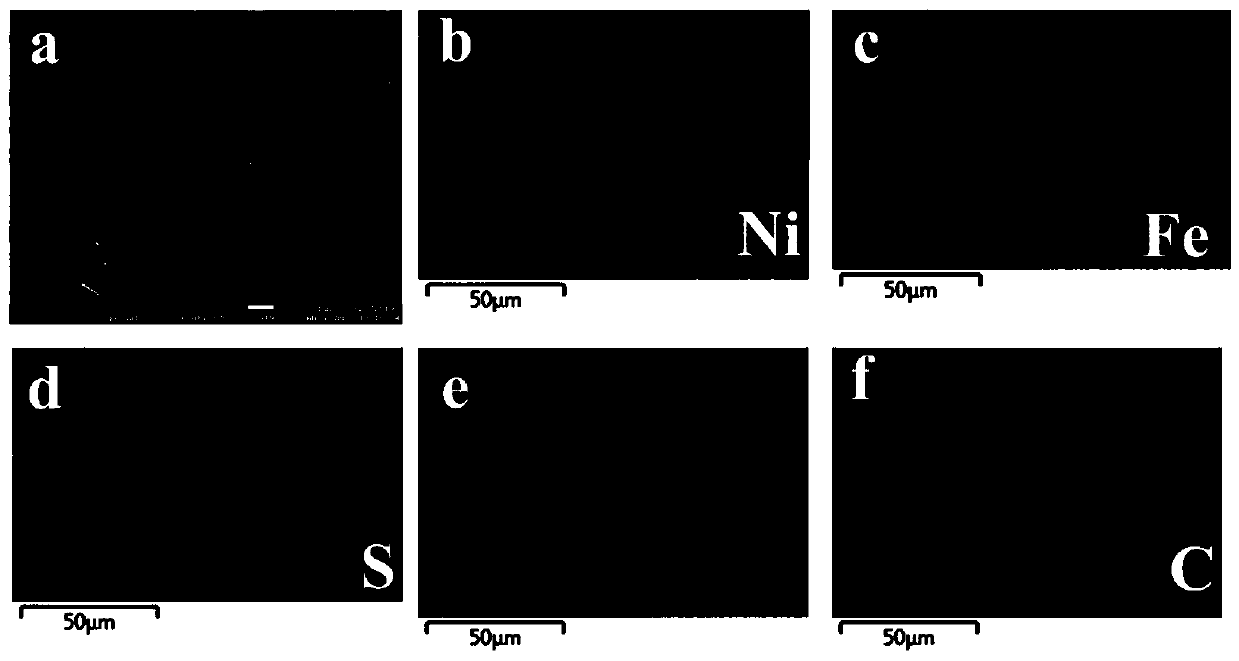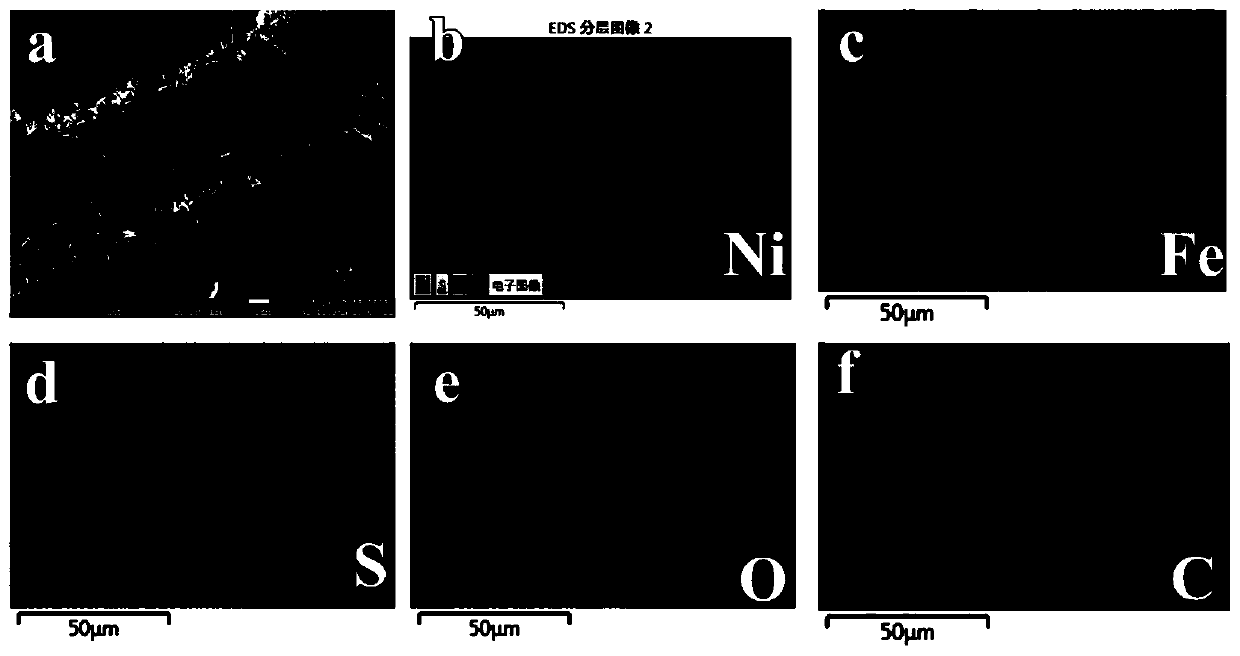Two-dimensional conductive metallic organic compound array, preparation method and application
A technology of organic compounds and conductive metals, which is applied in the field of nanomaterial preparation, can solve the problems of preparation of two-dimensional conductive metal-organic compound arrays that have not been reported, unfavorable charge and material transport, poor conductivity, etc., and achieve excellent electrocatalytic total hydrolysis activity , Raw materials are cheap and easy to get, the effect of overcoming poor conductivity
- Summary
- Abstract
- Description
- Claims
- Application Information
AI Technical Summary
Problems solved by technology
Method used
Image
Examples
Embodiment 1
[0040] Step 1: Dissolving 50mg of 2,5-thiophenedicarboxylic acid ligand and 50mg of ferrous chloride in ethanol;
[0041] Step 2: Foam nickel is placed in the solution described in step 1, in a closed container for 150 o C reaction 12h;
[0042] Step 3: washing and drying the obtained product to obtain an iron bimetallic (50 mg ferrous chloride) two-dimensional conductive metal organic compound array material.
[0043] The field emission scanning electron microscope image and element distribution diagram of the obtained nickel-iron bimetallic (50mg ferrous chloride) two-dimensional conductive metal-organic compound array are as follows figure 2 As shown, it indicates that the material is an ultrathin two-dimensional array, and each element is uniformly distributed. X-ray diffraction as Figure 8 (a), indicating that it is polycrystalline; Fourier transform infrared spectroscopy shows Figure 8 As shown in (b), 2972 and 2887cm -1 The weak peak at corresponds to the C-H ...
Embodiment 2
[0047] Step 1: Dissolving 50mg of 2,5-thiophenedicarboxylic acid ligand and 50mg of nickel acetate in ethanol;
[0048] Step 2: Foam nickel is placed in the solution described in step 1, in a closed container for 150 o C reaction 12h;
[0049] Step 3: washing and drying the obtained product to obtain a nickel two-dimensional conductive metal organic compound array material.
[0050] The field emission scanning electron micrograph and element distribution diagram of the obtained nickel two-dimensional conductive metal organic compound array are as follows: image 3 As shown in , it shows that the material is an ultrathin two-dimensional array, and the elements are evenly distributed; its electrical conductivity is between 23 and 40 S m -1 , indicating that it has good electrical conductivity. The linear sweep voltammetry curves of oxygen evolution reaction and hydrogen evolution reaction are as follows Figure 9 (a,c), at a current density of 10mA cm -2 The overpotentials ...
Embodiment 3
[0052] Step 1: Dissolving 50mg of 2,5-thiophene dicarboxylic acid ligand and 20mg of ferrous chloride in ethanol;
[0053] Step 2: Foam nickel is placed in the solution described in step 1, in a closed container for 150 o C reaction 12h;
[0054] Step 3: washing and drying the obtained product to obtain a nickel-iron bimetallic (20 mg ferrous chloride) two-dimensional conductive metal organic compound array material.
[0055] The field emission scanning electron microscope image and element distribution diagram of the obtained nickel-iron bimetallic (20mg ferrous chloride) two-dimensional conductive metal-organic compound array are as follows Figure 4 As shown, it indicates that the material is an ultrathin two-dimensional array, and each element is uniformly distributed. The linear sweep voltammetry curves of oxygen evolution reaction and hydrogen evolution reaction are as follows Figure 9 (a,c), at a current density of 10mA cm -2 The overpotentials were 253mV (oxygen e...
PUM
| Property | Measurement | Unit |
|---|---|---|
| Overpotential | aaaaa | aaaaa |
| Overpotential | aaaaa | aaaaa |
Abstract
Description
Claims
Application Information
 Login to View More
Login to View More - R&D
- Intellectual Property
- Life Sciences
- Materials
- Tech Scout
- Unparalleled Data Quality
- Higher Quality Content
- 60% Fewer Hallucinations
Browse by: Latest US Patents, China's latest patents, Technical Efficacy Thesaurus, Application Domain, Technology Topic, Popular Technical Reports.
© 2025 PatSnap. All rights reserved.Legal|Privacy policy|Modern Slavery Act Transparency Statement|Sitemap|About US| Contact US: help@patsnap.com



